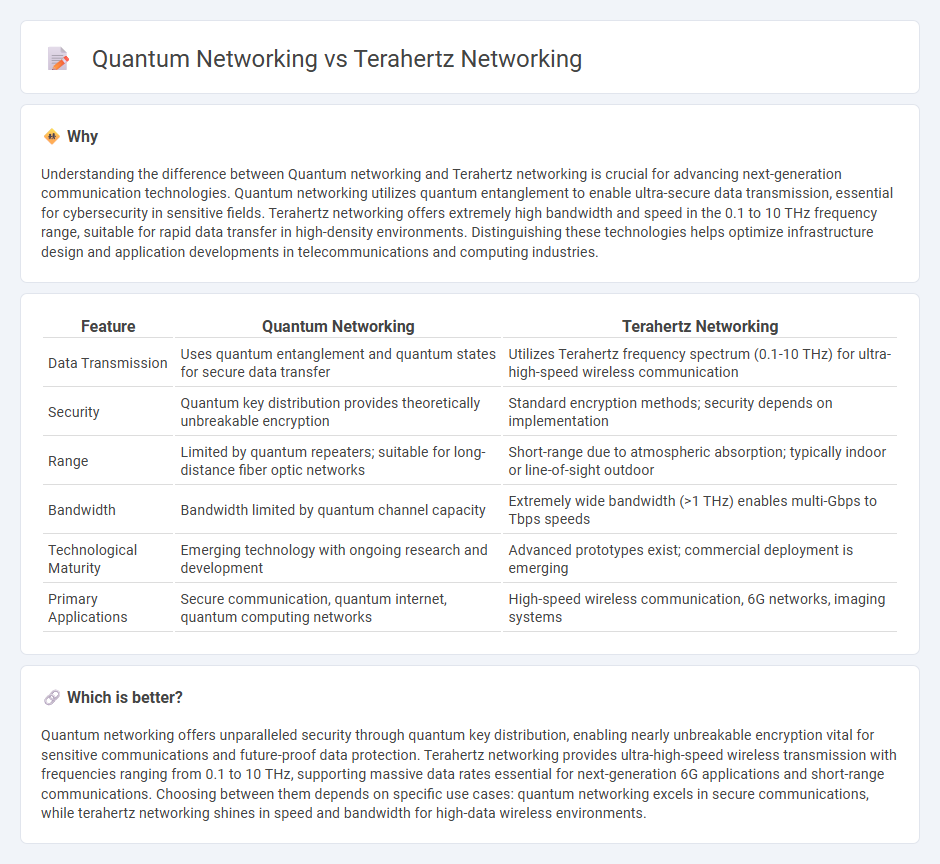
Quantum networking leverages the principles of quantum mechanics to enable ultra-secure communication and instantaneous data transfer through entangled particles, while Terahertz networking utilizes the electromagnetic spectrum between microwave and infrared frequencies for ultra-high-speed wireless communication. Both technologies aim to revolutionize data transmission but offer distinct advantages: quantum networking excels in security and quantum computing integration, whereas Terahertz networking promises unprecedented bandwidth and low latency ideal for next-generation wireless systems. Explore further to understand how these groundbreaking technologies will shape the future of connectivity.
Why it is important
Understanding the difference between Quantum networking and Terahertz networking is crucial for advancing next-generation communication technologies. Quantum networking utilizes quantum entanglement to enable ultra-secure data transmission, essential for cybersecurity in sensitive fields. Terahertz networking offers extremely high bandwidth and speed in the 0.1 to 10 THz frequency range, suitable for rapid data transfer in high-density environments. Distinguishing these technologies helps optimize infrastructure design and application developments in telecommunications and computing industries.
Comparison Table
| Feature | Quantum Networking | Terahertz Networking |
|---|---|---|
| Data Transmission | Uses quantum entanglement and quantum states for secure data transfer | Utilizes Terahertz frequency spectrum (0.1-10 THz) for ultra-high-speed wireless communication |
| Security | Quantum key distribution provides theoretically unbreakable encryption | Standard encryption methods; security depends on implementation |
| Range | Limited by quantum repeaters; suitable for long-distance fiber optic networks | Short-range due to atmospheric absorption; typically indoor or line-of-sight outdoor |
| Bandwidth | Bandwidth limited by quantum channel capacity | Extremely wide bandwidth (>1 THz) enables multi-Gbps to Tbps speeds |
| Technological Maturity | Emerging technology with ongoing research and development | Advanced prototypes exist; commercial deployment is emerging |
| Primary Applications | Secure communication, quantum internet, quantum computing networks | High-speed wireless communication, 6G networks, imaging systems |
Which is better?
Quantum networking offers unparalleled security through quantum key distribution, enabling nearly unbreakable encryption vital for sensitive communications and future-proof data protection. Terahertz networking provides ultra-high-speed wireless transmission with frequencies ranging from 0.1 to 10 THz, supporting massive data rates essential for next-generation 6G applications and short-range communications. Choosing between them depends on specific use cases: quantum networking excels in secure communications, while terahertz networking shines in speed and bandwidth for high-data wireless environments.
Connection
Quantum networking leverages quantum entanglement to enable ultra-secure communication channels, while terahertz networking uses terahertz frequency bands (0.1-10 THz) to achieve ultra-high-speed data transmission. Both technologies aim to revolutionize future communication infrastructure by enhancing bandwidth, security, and latency, with terahertz frequencies potentially serving as the physical layer for quantum key distribution and entanglement swapping. The integration of quantum protocols over terahertz wireless links is a promising research direction to realize scalable, high-capacity quantum internet systems.
Key Terms
Bandwidth (Terahertz)
Terahertz networking offers ultra-high bandwidth capabilities, reaching frequencies from 0.1 to 10 THz, enabling data rates up to several terabits per second, which far exceed current wireless communication standards. Quantum networking, while revolutionary for secure communication using quantum bits, currently faces bandwidth limitations due to the complexity of quantum state transmission and error correction. Explore the technological advancements and applications driving the future of high-speed data transfer in terahertz and quantum networks.
Quantum Entanglement (Quantum)
Quantum entanglement enables instantaneous correlation between particles over vast distances, forming the basis of secure quantum networking protocols that surpass classical limitations. Terahertz networking, operating in the 0.1-10 THz frequency range, offers ultra-high bandwidth and low latency but lacks the intrinsic security features driven by quantum phenomena. Explore the advancements in quantum entanglement to understand the future of ultra-secure communication technologies.
Security (Quantum Key Distribution)
Terahertz networking offers ultra-high-speed data transmission with limited range, whereas quantum networking specializes in unparalleled security through Quantum Key Distribution (QKD), enabling theoretically unbreakable encryption based on quantum mechanics. QKD protocols, such as BB84, utilize quantum states to detect eavesdropping attempts, ensuring secure key exchange immune to computational attacks. Explore the cutting-edge advances in quantum cryptography and terahertz communication to understand their impact on future secure networks.
Source and External Links
Terahertz Communication: Shaping the Future of Wireless Technology - Terahertz (THz) communication employs electromagnetic waves between 0.1 and 10 THz to achieve ultra-high-speed wireless networks, enabling data rates from gigabit to terabit per second for applications like VR, AR, and high-speed local area networks, while also enhancing intra-chip connectivity and server farm wireless links.
What is Terahertz Communication? - Lightyear.ai - Terahertz communication uses the 0.1-10 THz frequency range to provide ultra-fast wireless data transmission with higher bandwidth, supporting next-generation technologies such as 6G, and benefiting applications like 8K streaming, virtual reality, and advanced security through imaging.
Terahertz Sensing and Communication Towards Future Intelligence ... - The THz band is a key technology for 6G and beyond, delivering ultra-high user data rates in the terabit-per-second range, enabling holographic communication, ultra-large capacity backhaul, and high-precision sensing and imaging with safe, non-ionizing radiation suitable for communication and sensing integrated applications.
 dowidth.com
dowidth.com